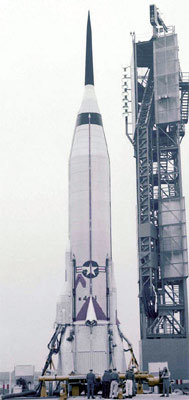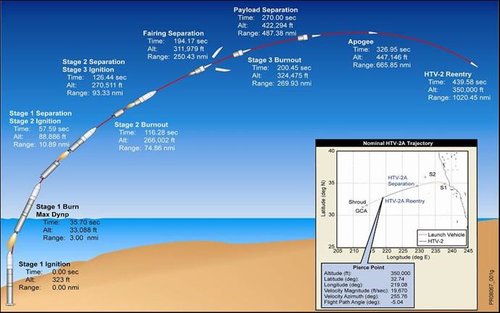For some odd reason this dropped off the original reply:
Ya we had a nuclear powered cruise missile that was designed to do that But no, each 'explody' bit counts as a warhead, better men than us have tried to bypass that one
But no, each 'explody' bit counts as a warhead, better men than us have tried to bypass that one 
Actually if we're being technically honest it IS just a matter of manuverability in that the interceptor can't manuever to match an incoming target at hypersonic speed if the target 'jinks' near intercept. (And now we understand why everyone wanted to use nuclear warheads for everything... Frustration rearing its ugly head and all that )
)
Yep as long as the incoming can maintain hypersonic speed the interceptor has little chance of generating a successful hit. Of course the further and more sharply the HGV/MARV manuervers the more speed it loses and the further it travels the more it loses and pretty soon even if you hit atmosphere at Mach 27 and survived to impact your speed is a LOT less near the target.
And while interceptors have a hard time making a direct kill if you launch enough of them and/or put up enough debris, (continious rods, metal/explosive mesh, chunks of shrapnel, heck beehive rounds from rapid fire cannon could do the job) the HGV/MARV is very likely to run into something that will damage it enough for its own speed to destroy it.
Terminal defense is both where the target and attacker are most vulnerable.
Now having said that, I'll also admit that as 'scary' as HGV/MARV may be there are actually worse out there
IIRC it has but results are mixed at best since you have both range and the atmopshere working against you. Power density is an issue I think I remember. You needed a pretty big and powerful platform to get any good results and then there is the whole 'light up and everyone can see you' with ASat's with jamming trackers being a thing.
There isn't? Your PBV is your interface with the missile and carries you GNC and computer system for the whole missile. The PBV also provides power and support till the payload is released and coure corrections prior to atmosphereic entry. Specifically in the HGV case it likely provides you propulsion 'boost' prior to entry so you have more speed to play with. Even if the support is only minimumal you will have a PVB-like structure for mounting the HGV to the missile because there' no 'payload' connection built into the missile itself.
So you're still 'swapping' the PBV assembly between warhead types.
I'll buy those but will point out the penetrator is supposed to already exist in everyones arsenel?
Randy
You could even have a MIRV HGV to really annoy the enemy. I'm sure it would just count as one warhead in START right?
Ya we had a nuclear powered cruise missile that was designed to do that
It's not just a matter of manoeuvrability, a HGV is very fast, hitting it whilst it takes a fix ballistic path is difficult but when it starts moving you will suffer huge problems with control lag. For instance, the current THAAD will not work against HGVs, even IRBM or MRBM HGVs/MARVs and they are looking at a new version that does.
Actually if we're being technically honest it IS just a matter of manuverability in that the interceptor can't manuever to match an incoming target at hypersonic speed if the target 'jinks' near intercept. (And now we understand why everyone wanted to use nuclear warheads for everything... Frustration rearing its ugly head and all that
Yep as long as the incoming can maintain hypersonic speed the interceptor has little chance of generating a successful hit. Of course the further and more sharply the HGV/MARV manuervers the more speed it loses and the further it travels the more it loses and pretty soon even if you hit atmosphere at Mach 27 and survived to impact your speed is a LOT less near the target.
And while interceptors have a hard time making a direct kill if you launch enough of them and/or put up enough debris, (continious rods, metal/explosive mesh, chunks of shrapnel, heck beehive rounds from rapid fire cannon could do the job) the HGV/MARV is very likely to run into something that will damage it enough for its own speed to destroy it.
Terminal defense is both where the target and attacker are most vulnerable.
Now having said that, I'll also admit that as 'scary' as HGV/MARV may be there are actually worse out there
Has jamming the defence radars from space during a strike been tried?
IIRC it has but results are mixed at best since you have both range and the atmopshere working against you. Power density is an issue I think I remember. You needed a pretty big and powerful platform to get any good results and then there is the whole 'light up and everyone can see you' with ASat's with jamming trackers being a thing.
You can use the same booster, but its not as simple as swapping payloads. The GN&C has to be changed as the trajectories are not the same at all, and the booster will not be optimized for one of the two missions so there will be a payload loss.
Still unclear since there's no PBV needed for the HGV.
This. 3-stage ICBM to push an HGV platform or swap that platform out for a 4th stg PBV with MaRVs.
There isn't? Your PBV is your interface with the missile and carries you GNC and computer system for the whole missile. The PBV also provides power and support till the payload is released and coure corrections prior to atmosphereic entry. Specifically in the HGV case it likely provides you propulsion 'boost' prior to entry so you have more speed to play with. Even if the support is only minimumal you will have a PVB-like structure for mounting the HGV to the missile because there' no 'payload' connection built into the missile itself.
So you're still 'swapping' the PBV assembly between warhead types.
Two fairly easy arguments for the HGV:
a. attacking a very hard target in the geometric shadow of a mountain (a pretty obvious defensive ploy against a fixed ICBM threat)
b. delivering a nuclear earth penetrator within the angle of obliquity and velocity tolerances of penetrator
I'll buy those but will point out the penetrator is supposed to already exist in everyones arsenel?
Randy



